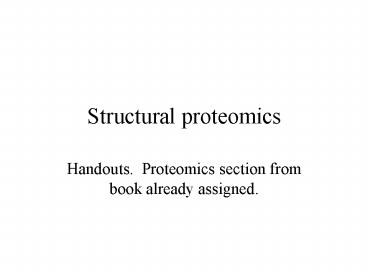Structural proteomics - PowerPoint PPT Presentation
1 / 20
Title:
Structural proteomics
Description:
Structural proteomics Handouts. Proteomics section from book already assigned. – PowerPoint PPT presentation
Number of Views:152
Avg rating:3.0/5.0
Title: Structural proteomics
1
Structural proteomics
- Handouts. Proteomics section from book already
assigned.
2
What is structural proteomics/genomics?
- High-throughput determination of the 3D structure
of proteins - Goal to be able to determine or predict the
structure of every protein. - Direct determination - X-ray crystallography and
nuclear magentic resonance (NMR). - Prediction
- Comparative modeling -
- Threading/Fold recognition
- Ab initio
3
Why structural proteomics?
- To study proteins in their active conformation.
- Study proteindrug interactions
- Protein engineering
- Proteins that show little or no similarity at the
primary sequence level can have strikingly
similar structures.
4
An example
- FtsZ - protein required for cell division in
prokaryotes, mitochondria, and chloroplasts. - Tubulin - structural component of microtubules -
important for intracellular trafficking and cell
division. - FtsZ and Tubulin have limited sequence similarity
and would not be identified as homologous
proteins by sequence analysis.
5
FtsZ and tubulin have little similarity at the
amino acid sequence level
Burns, R., Nature 391121-123 Picture from E.
Nogales
6
Are FtsZ and tubulin homologous?
- Yes! Proteins that have conserved secondary
structure can be derived from a common ancestor
even if the primary sequence has diverged to the
point that no similarity is detected.
7
Current state of structural proteomics
- As of Feb. 2002 - 16,500 structures
- Only 1600 non-redundant structures
- To identify all possible folds - predicted
another 16,000 novel sequences needed for 90
coverage. - Of the 2300 structures deposited in 2000, only
11 contained previously unidentified folds. - Overall goal - directly solve enough structures
directly to be able to computationally model all
future proteins.
8
Protein domains - structure
- clearly recognizable portion of a protein that
folds into a defined structure - Doesnt have to be the same as the domains we
have been investigating with CDD. - RbsB proteins as an example.
9
Main secondary structure elements
- a-helix - right handed helical structure
- b-sheet - composed of two or more b-strands,
conformation is more zig-zag than helical.
10
Images from http//www-structure.llnl.gov/Xray/tut
orial/protein_structure.htm http//www.expasy.org/
swissmod/course/text/chapter1.htm
11
Folds/motifs - tertiary structure
- How these secondary structure elements come
together to form structure. - Helix-turn-helix
- Determining the structure of nearly all folds is
the goal of structural biology
12
Quaternary structure
- Refers to the structure formed by more than one
polypeptide. - Many proteins function as complexes - best to
know the structure of the complex rather than
each individual - Proteins may have different conformations when in
a complex vs. alone.
13
X-Ray Crystallography
- Make crystals of your protein
- 0.3-1.0mm in size
- Proteins must be in an ordered, repeating
pattern. - X-ray beam is aimed at crystal and data is
collected. - Structure is determined from the diffraction
data.
14
Image from http//www-structure.llnl.gov/Xray/101i
ndex.html
15
Schmid, M. Trends in Microbiolgy, 10s27-s31.
16
X-ray crystallography
- Protein must crystallize.
- Need large amounts (good expression)
- Soluble (many proteins arent, membrane
proteins). - Need to have access to an X-ray beam.
- Solving the structure is computationally
intensive. - Time - can take several months to years to solve
a structure - Efforts to shorten this time are underway to make
this technique high-throughput.
17
Nuclear Magnetic Resonance Spectroscopy (NMR)
- Can perform in solution.
- No need for crystallization
- Can only analyze proteins that are lt300aa.
- Many proteins are much larger.
- Cant analyze multi-subunit complexes
- Proteins must be stable.
18
Structure modeling
- Comparative modeling
- Modeling the structure of a protein that has a
high degree of sequence identity with a protein
of known structure - Must be gt30 identity to have reliable structure
- Threading/fold recognition
- Uses known fold structures to predict folds in
primary sequence. - Ab initio
- Predicting structure from primary sequence data
- Usually not as robust, computationally intensive
19
Structure of the ribosome
- Ribosome - made up of 3 RNA molecules and over 50
proteins. - Structure of the 70S ribosome solved by combining
several models of the individual 30S and 50S
subunits
20
Bacterial ribosome
- Ribosome is a 2.3 MDa complex
- 50S and 30S subunits
- 54 proteins and 3 RNAs (23S, 16S, and 5S RNAs)
- Can account for 50 of cell mass during rapid
growth. - Major target for many antibiotics.
- Ribosome is a ribozyme!
Ramakrishnan (2002) Cell. 108557-572































